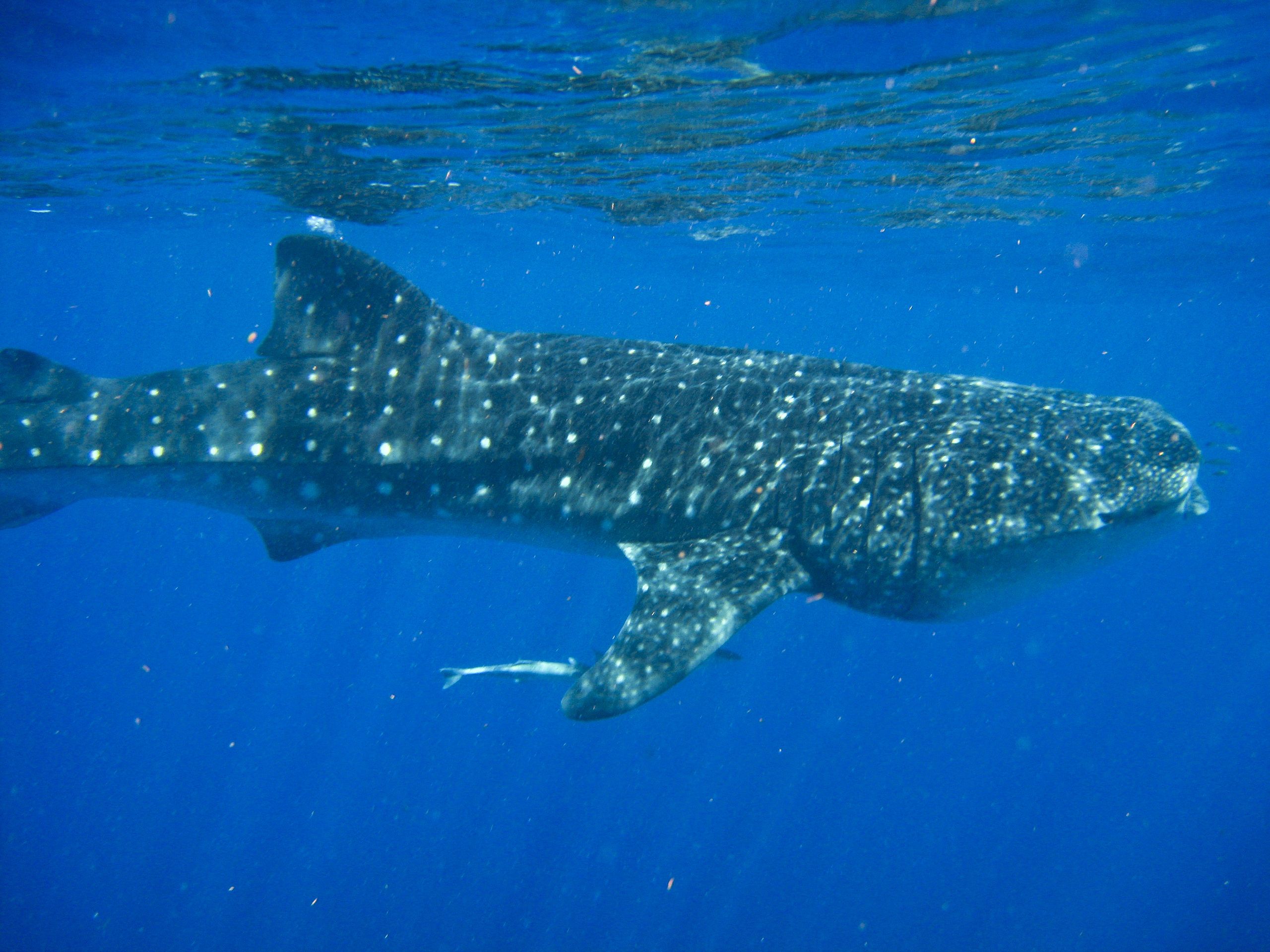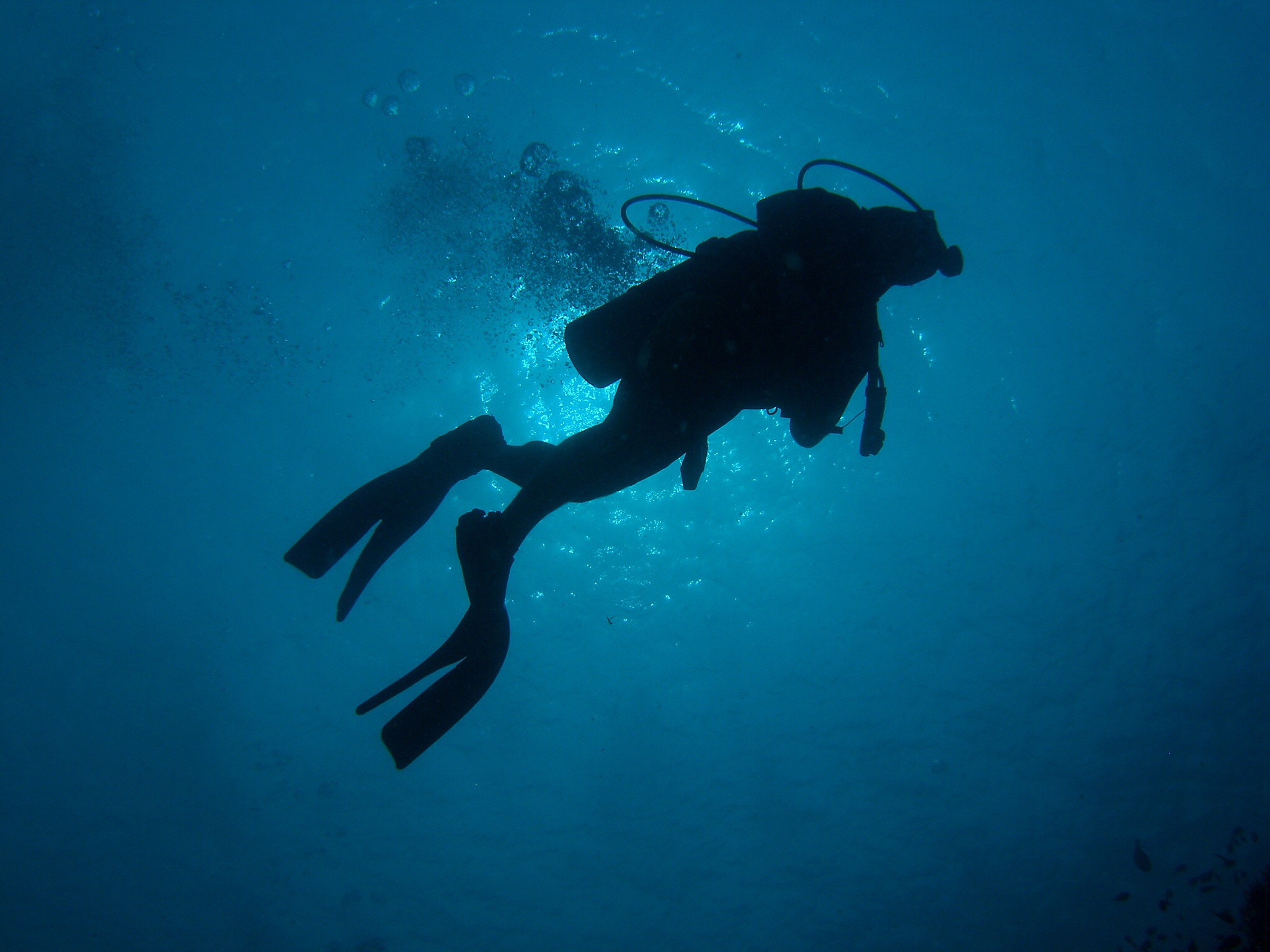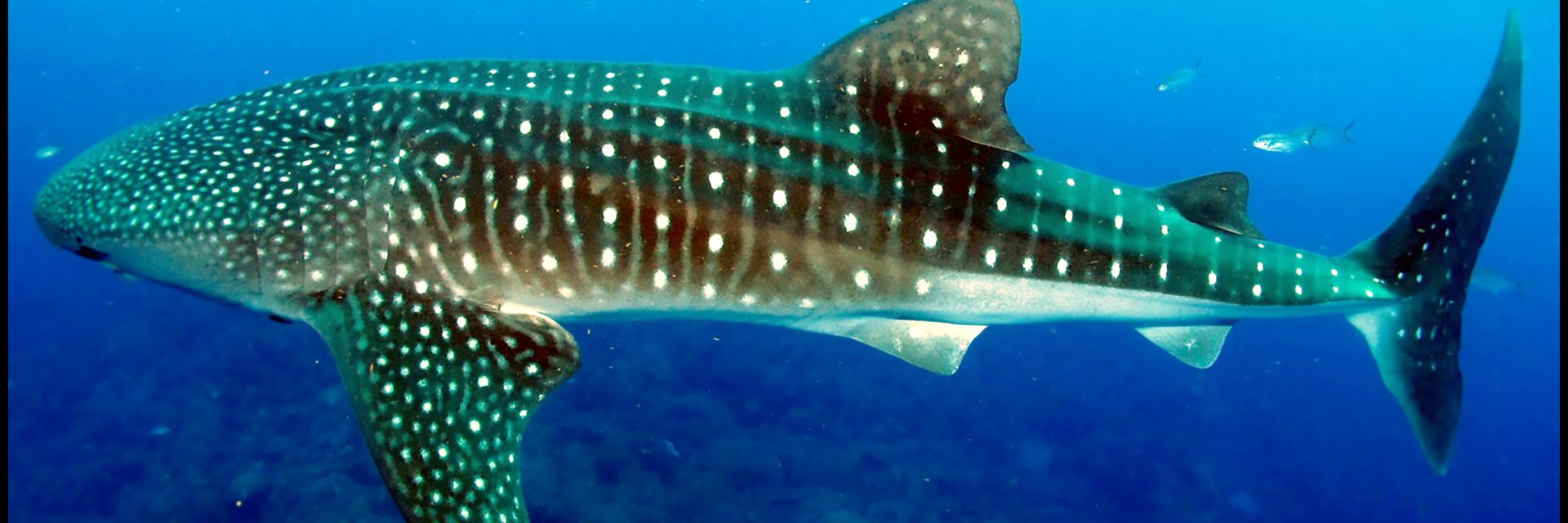Will space-age technology help save the largest fish on Earth – the whale shark? Despite their size, whale sharks are threatened by overfishing and the appalling practice of “finning.” Organizations now exist to educate governments and the public about the plight of these magnificent fish, including a group that has enlisted NASA scientists to aid in tracking the mysterious species.
◊
From Mozambique to Madagascar, and Belize to Bali, coastal waters are perfect for studying myriad fish and other types of sea life. Whales, sharks, sea turtles (pretty much the entire cast of Finding Nemo) gather offshore for the good eating, and possibly for companionship as well.
One of the most magnificent of all ocean inhabitants is the whale shark. It is incredibly ancient, remarkably docile, tireless in its travels, and bigger than any other shark – indeed, any other fish – in the sea. Only certain whale species are larger. Large schools of whale sharks, intriguingly separated by sex, gather together in the relatively shallow, food-rich waters of tropical zones across the globe. Why the gender segregation and the large groups? As with many of their behaviors, we just don’t know.
What Whale Sharks Let Us Know
So, let’s start with what we do know: Whale sharks aren’t whales, or even related to them. They’re sharks, the biggest of their kind. Adults can reach up to 40 feet long and a seemingly gravity-defying seven tons, and some sea-life specialists have hypothesized that the largest of these fish can grow to a humongous 65 feet and up to 34 tons!
Another fun fact is that whale sharks have more teeth than any other type of shark (including the fierce great white), about 300 rows of them. But their teeth are only about the size of match heads, so don’t worry about them chasing after you for a quick snack. Rather, whale sharks are connoisseurs of tiny krill, aficionados of fish eggs, gastronomes of kelp. And, given that their enormous mouths extend fully across their broad faces, they often just swim with their mouths agape to get, one might say, their fill of krill.
Whale sharks are known as “filter-feeders.” Rather than relying on their teeth to chew, these gigantic fish have a structure inside their broad mouths that covers the entrance to their digestive system much like a pad, with tiny holes through which water flows. This dense filtering system allows them to swallow immense quantities of sea life, then expel just the excess water.
Passive swallowing may be a fine way to bring in an average meal, but whale sharks can also scarf down enormous quantities of food by opening and shutting their jaws in a rapid motion that creates a powerful suction effect, trapping pretty much anything right in front of them and pulling it straight into their digestive systems.
.jpg)
Source: Lakshmi Sawitri, via Wikimedia Creative Commons
What Whale Sharks Keep Secret
Some creatures are easy to study, and biologists have revealed almost everything about them worth knowing. Whale sharks are definitely not one of those creatures. In fact, they are among the most mysterious of sea animals, and they seem loath to give up their secrets. Despite years of observation and tracking surveys, we still don’t know:
- How they mate
- Where they mate, i.e., where their breeding grounds are
- Where, when, or how they give birth
- How large their litters are
- What they do when they gather en masse during particular times of the year
- How many there are, and their distribution among the world’s seas
However, even without a reliable census, we do know that they are an endangered species. Whale sharks have been overfished for many years and are only now beginning to receive the protections afforded to animals whose habitats, or whose ability to flourish, are threatened.
Whale sharks have long been hunted for their fins, which are all too often used to attract people into markets or restaurants. And certain cultures prize a dish called shark’s fin soup, even though harvesting fins is akin to harvesting ivory – a tragic price to pay for such a questionable addition to the dinner table.
For Whale Sharks, One Ocean Just Isn’t Big Enough
Although some people understandably assume that whale sharks primarily inhabit the Pacific Ocean, they actually have a much larger range. In fact, they gather at some really hot vacation spots and have been seen in temperate and tropical waters all over the world, including in shallow waters off Qatar, Belize, and islands of the Indian Ocean.
With so many places to hang out, you might think there have been ample opportunities to observe all the usual important elements of their life cycles – feeding, mating, birthing, death, etc. But, as we’ve learned, whale sharks are adept at hiding from prying eyes. For instance, it remains a mystery whether all pregnant whale sharks visit one place on Earth to give birth, or whether there are numerous “pupping grounds” across the globe.
Whale sharks are ovoviviparous. This means that, like certain reptiles and snakes, female whale sharks carry their pre-natal young inside them from the egg (ovo) stage through early development to viability, and give birth to live (vivi) offspring.

Source: ImTurismo, via Wikimedia Creative Commons
Because our knowledge of the whale shark’s life cycle is so limited, our understanding of whale shark birth and nurturing is based on an examination of only a single pregnant female that was captured in a fishing expedition, in 1995, and examined intensively over time. This individual had around 300 eggs in different stages of development in her womb – all fertilized by the same male! From this case, experts speculate that each whale shark pup is born separately as it becomes viable, though this conjecture is obviously based on extremely limited observation.
The Whale Shark “Party Circuit”
One thing we know for sure is that whale sharks do get around. Based on data collected using tagging and tracking, we’ve learned they can travel thousands of miles in a short period of time, sometimes apparently alone, sometimes in small groups. Males have been seen congregating in shallow waters off the coasts of Peru and Ecuador. Females seem to prefer such chi-chi, warm water destinations as the aforementioned Belize, the western coast of Australia, Christmas Island in the Indian Ocean, and their most popular hang-out, the Galápagos Archipelago. In the Galápagos, they particularly favor an area at the tip of the archipelago just off Darwin Island and its unique natural rock formation called Darwin’s Arch.
The Arch is the most studied location for whale shark behavior, but it’s still not known why pregnant whale sharks gather there, as they have not been observed mating or giving birth there. And though we guess from their size and shape that these sharks are pregnant, the technology that is used to gauge their condition – the ultrasound machine – is of little use in determining the fecundity of the fish. Current machines can detect activity in creatures whose flesh is 1” to 1-1/2” thick (which is fine, say, for use on pregnant women), but the skin of whale sharks, even across their relatively tender bellies, can be an astounding eight inches thick.
So why is Darwin’s Arch so popular? Could it be that whale sharks’ preferred food is especially abundant there? The only sighting of a whale shark consuming anything larger than small fish – an apparently delicious meal of snapper and grouper – was at the Arch, but that’s not a whole lot on which to base conclusions. Or maybe the Galápagos Archipelago (and Darwin Island in particular) is just a well-known migration waypoint, a dot in the ocean off Ecuador that’s on the must-visit list for any self-respecting female whale shark – and the occasional adventurous male who comes to frolic in the surf and spray. Who knows?
A Specialist in Whale Shark Behavior (What We Know of It, Anyway)
Perhaps the most likely person to discover the basis of this curious travel behavior is someone who spends considerable time on the ocean around Darwin Island observing whale sharks and tagging them to track their movement from one gathering place to another.
Jonathan Green is this man, and his work is the subject of an intriguing documentary titled Galápagos: Realm of Giant Sharks. He studied earth sciences from an early age and was interested in dinosaurs and other early Earth species, so it comes as no surprise that he is quick to remind us that whale sharks are one of the planet’s oldest species, possibly extending back 300 million years. If he’s right (and he probably is), these fish were around before the dinosaurs and somehow survived the mass extinction that killed off most other species 65 million years ago.
Conservationist Jonathan Green plans to continue his study of whale sharks in their natural habitats by gathering additional population data in the Ecuadorian Islands in late 2018.
Whale sharks appear in the Galápagos Archipelago several months each year, between July and December, but why? Is it to hook up with mates (even though courtship and mating itself likely occurs elsewhere)? Is it because the krill, kale, and fish eggs they prefer to eat are historically plentiful here? Or do these whale sharks just enjoy the gradually cooling temperatures of the local waters in late summer through the fall? For years, like a modern-day Charles Darwin, Green has been leading expeditions and educational trips to study whale sharks and other fauna that gather around the Galápagos Islands. He hopes one day to discover the reason (or reasons) that the waters of the Galápagos region seem to have a magnetic attraction for whale sharks, especially pregnant ones.
Time and study will (we hope) tell the tale, but for now Green is in intense observation mode, tagging as many whale sharks as he can, then attempting to keep track of their travels through the oceans.

Source: Clotho, via Wikimedia Creative Commons
How Studying the Stars Could Be Key to Tracking Whale Sharks
While there is much to learn about whale sharks, they are impossible to miss when you see one. They’re as big as a tractor-trailer rig, have milky white underbellies, flat snouts, and dazzling, star-like patterns on their backs. Careful observation reveals that no two of the fish have precisely the same spot patterns, so tracking them by these identifiers could be an effective way to learn more about their migratory habits.
With this in mind, digital information architect Jason Holmberg had an idea that using the star patterns on their backs might work as a way to track them. Soon, he was joined by NASA astrophysicist Zaven Arzoumanian, who was intrigued by the possibilities of using astral technology for oceanographic purposes.
In their discussions and tests, they came upon an algorithm that had been developed back in 1986 to distinguish star patterns in relatively tiny parts of the night sky. This algorithm, named after its discoverer, physicist Edward J. Groth, was developed in preparation for the enormous amounts of data that would be captured by the Hubble Space Telescope.
Arzoumanian and Holmberg believed, correctly, that this mathematical formula could also be modified to identify whale sharks by the star-like spot patterns on their back. To advance their idea, they affiliated with an Australian nonprofit organization devoted to studying and protecting the largest fish in the sea. The organization, ECOCEAN, not only tracks whale sharks by satellite tags, it now also uses the modified Groth’s Algorithm for a special, crowd-sourced photo-identification project. Scuba divers and ecotourists who encounter whale sharks are encouraged to take photos of the distinctive star patterns and submit them, with date and location of the shots, to ECOCEAN to add to their database.
ECOCEAN is an international conservation and educational nonprofit headquartered in Australia, where – off its western coast – whale sharks congregate in large numbers. In the United States, a sister organization called Wildbook for Whale Sharks participates in tracking and identification.
This ingenious collaborative effort has allowed the folks at ECOCEAN to build a database of individual whale sharks and to develop better methods for tracking their movements, and even more. The data that is being collected can be used to influence international bodies to take further steps to protect whale sharks from fishermen and other trophy hunters.
Charting a Healthy Future for Whale Sharks
It’s too early to tell if conservation strategies in western Australia and the Galápagos Islands will be successful in the long term, but techniques and tactics are in place, supported by laws such as the U.S.’s Marine Mammal Protection Act of 1972 (and its more recent amendments), as well as by international agreements to curtail ocean harvesting of this threatened species.
Look at this as a race against time. Oceanographers and naturalists are working hard to learn more about whale sharks, their life habits, and the threats they face. They are engaged in these urgent efforts so that they can go to governments and international bodies with hard data to support the need to implement new protections for these great, ancient fish. Without both elements of this equation – data derived from exploration, and protection under national and international law – whale sharks could face an uncertain future that may not include them.
You can help, too, if you are fortunate enough to spot a whale shark in the wild and have a camera ready. Just visit the ECOCEAN Photo Identification website for detailed information.
Ω
Kevin Martin is Senior Writer for MagellanTV. He writes on a wide variety of topics, including outer space, the fine arts, and modern history. He has had a long career as a journalist and communications specialist with both nonprofit and for-profit organizations. He resides in Glendale, California.
Title image: Rhincodon typus. (Credit: NOAA, via Wikimedia Commons)

